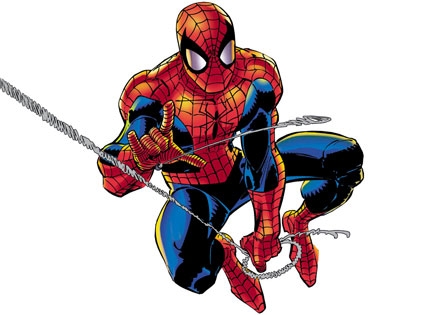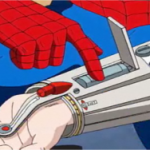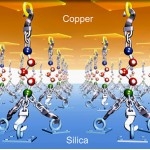
Putting the “Science” in “Science Fiction” – Spiderman
There are many superheroes and villains who rely on technological gadgets and devices to provide them with their superhuman abilities, and inventors and scientists often look to these characters for inspiration for new technology. However, it is not only these gadget heroes who are being imitated by scientists in the real world. Peter Parker, also known as Spiderman, is a character who received most of his powers when he was bitten by a spider that had been irradiated, or genetically modified (depending on the story.) This spider bite gave Peter enhanced strength and toughness, as well as the wall crawling and sensory abilities of a spider. Unlike his other powers, Spiderman’s trademark webs came from a pair of web-shooters he invented and built into his costume as shown in the upcoming Spiderman movie. Scientists have been examining both Spiderman’s climbing ability and his web-shooters, and believe they are coming close to imitating them in the real world.

A system that allows people to climb walls and other vertical surfaces would have many applications, from commercial to purely recreational, and Professor Nicola Pugno and his colleagues at Polytechnic of Turin, Italy have been examining how to make this system a reality. Although there are many ways a person could attach to a surface, such as certain adhesives, the problem with creating a wall-climbing system is allowing the person to detach the adhesive from a surface and then reattach it. Pugno and his associates have been studying spiders, geckos, and other animals that move about effortlessly on walls and ceilings, and think they have found a way to allow humans to perform similar feats. According to these researchers wall-crawling animals like geckos use a phenomenon known as “Van Der Waals Forces,” where molecules that are brought very close together show a weak attraction to each other, to enable them to cling so persistently. In the gecko’s or spider’s case this effect is caused by many tiny hairs on their feet. Previously scientists believed that using this method would not work to suspend something as heavy as a person, but Pugno’s research has shown that a properly engineered system using Van Der Waals Forces would have enough strength to handle a person’s weight.
In order to create a system that will allow people to climb walls like Spiderman Pugno’s team is looking into using carbon nanotubes, the same wonder material I talked about in my last blog entry. These researchers believe that when nanotubes are properly aligned they will grip structures on a microscopic level, like a much stronger version of Velcro, and will cling to anything. The plan is to mount this system into boots and gloves, allowing people to use them to climb in much the same way Spiderman does. Due to the form and nature of these nanotubes they are also water-resistant and self-cleaning, which will allow people to use them on wet or dirty surfaces without worrying about slipping. Although making climbing kits is the main object of this research right now it has other possible uses, including non-slip shoes and gloves, and Pugno and his team believe this technology will also be useable underwater and in space. If they are correct than this use of nanotubes will not only allow normal people to imitate Spiderman, they will be very helpful to those exploring the deep sea and places beyond Earth’s atmosphere.

Besides his ability to climb one of Spiderman’s most signature powers is his ability to shoot webs to swing around or entangle criminals. In the comics Spiderman invented a pair of wrist mounted launchersto fire a fluid that hardened and developed a web like consistency. The webs these launchers produced were very strong and sticky, but disintegrated after half an hour, leaving no trace of them behind. He used these webs to swing around the city of New York, quickly climb or descend buildings, and battle criminals and super villains. A real life version of these web-shooters would be useful in many different roles, including mountaineering, rescue, law enforcement, and many others.

By combining old technology with cutting edge developments it will likely be possible to produce web-shooters like those Spiderman uses fairly soon. The technology to launch pressurized fluid from a can already exists, and can be found in cheaply available Silly String containers. If the web-shooter concept was being actively pursued then this technology could easily be enhanced to make it shoot farther and more accurately, though this would increase its cost. The challenge of making a thin thread capable of supporting a person’s weight could be solved using carbon nanotubes, as their light weight and amazing strength makes them the perfect material for such applications. Carbon nanotube’s strength is based partially on how they are aligned, and it should be fairly easy to combine them into a fluid that would align them properly when they were fired from a launcher. This fluid could be designed to disintegrate over time, and this would mean that webs would not hang around to cause a problem for too long, much like Silly String eventually dissolves. The only aspect of Spiderman’s web shooters that these technologies do not answer is the stickiness required to allow a person to attach them to any surface and swing from them. The answer to this problem comes in the form of nanoglue, a newly designed adhesive made from chains of molecules, that is stronger than any other type of glue yet known and can bond almost any materials together. By attaching nanoglue to the end of the web-line it would allow the user to attach a line to almost any surface and, if properly mixed with the disintegrating fluid, would dissolve afterwards and leave no trace behind. If these separate technologies are brought together it may not be long before people the world over can swing around like Spiderman without worrying about leaving huge artificial cobwebs hanging around all over town.












